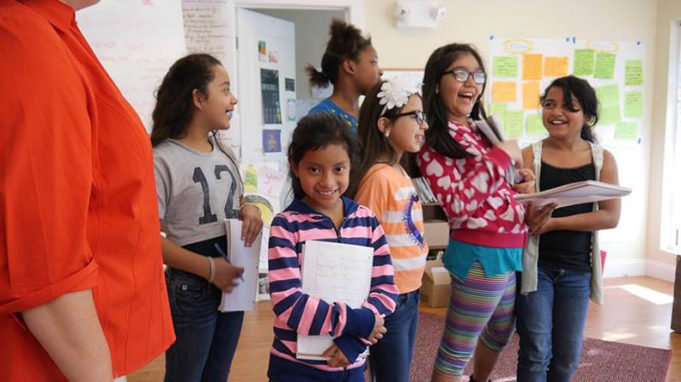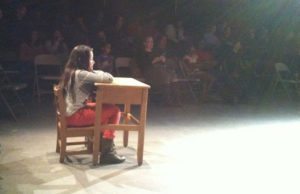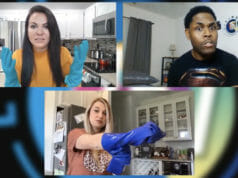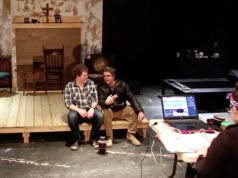Many studies have noted the positive effect of the arts in public education, but it’s primarily music and the visual arts that are emphasized. At the Manton Avenue Project (MAP), in Providence, Rhode Island’s Olneyville neighborhood, however, the focus is on creating original theatre by connecting students from third-grade through high school with theatre professionals.
Within MAP’s construct the students write plays with mentors, and adults most often direct and act in the plays. But just how are kids and theatre a winning combination?
“The idea of offering up the stage to a young person and saying, ‘This is your space, right here, right now, we are all listening to you,'” begins MAP’s executive/artistic director Meg Sullivan. “There’s something magic about the live moment.”
The students are learning that what they have to say is important and should be heard
A founding member of Elemental Theatre Collective and the chair of MAP’s board of directors Kelly Seigh concurs: “The students are learning that what they have to say is important and should be heard. Nothing is wrong. And there’s a sense of pride when the show is complete and being shown to an audience.”
MAP was founded in 2004 by Jenny Peek, who had worked at the 52nd St. Project in New York City and who came to Rhode Island to use that model to initiate a playwriting program among students in one of Providence’s low-income neighborhoods. She remained MAP’s director until Sullivan came on board in 2011.
Peek established the core program, which involved students from third grade through seventh grade, with different ways for individuals to create plays for the first two grades, then working in teams in fifth and sixth grades and co-starring with an adult actor in dialogues for fifth through seventh graders.
Two years ago, when the organization moved into its very own space, called “The Clubhouse,” two new programs were added: “Fun Fridays” with guest artists and Teen Voices for seventh through twelfth graders. A grant to the Olneyville Housing Agency specified two community spaces, and MAP landed one of those, just two blocks from the William D’Abate Elementary School in Olneyville.
Approximately 75 students cycle through the MAP programs each year, and MAP works hard to carry 10 students from each grade through five years of the project.
“We’re trying to set up this long-time commitment,” Sullivan stresses. “We really get to know each child and each family.”
Sullivan has also introduced “themes” into the playwriting, such as endangered species, outer space, gardening, small business and public parks. Once she’s settled on a theme, she invites experts to talk to the students, which means that each project involves research before the writing begins. In addition to what they are absorbing about the topic at hand, they are learning problem-solving, conflict-resolution and collaboration, because that’s always part of the process of putting on a play.
Casey Seymour-Kim, a member of Gamm Theatre’s acting company, has been with MAP since the get-go. In the first play, she portrayed George Washington’s dog, Lucky, who turns into a super-villain, Wormy, after an encounter with “toxic ooze.” She points out that MAP offers opportunities to enhance literary and critical thinking and thereby gives its participants a sense of empowerment.
“We often dismiss the ideas and opinions of children, especially those from lower socio-economic circumstances,” she points out. “But in performance, we honor their opinion or argument or point of view, and they feel their ideas are worth listening to.”
The imagination and creativity that these students bring to their work is truly inspiring
Brien Lang and his wife Clare Blackmer, founding artists with the Wilbury Theatre Group, have been involved in MAP for nine years. Lang praises the “community-creating experience” the young playwrights get at MAP when their plays are designed, directed and acted in by local professionals.
“The imagination and creativity that these students bring to their work is truly inspiring,” he observes. “Where else would an actor get the chance to play a guitar-playing monkey lawyer, the ghost of a saber-toothed tiger or a ninja-egg-stealing skunk? It’s the best gig in town!”
Apparently, the students agree. Raymond, 11, says, “At MAP, I get to write a play and show the world who I am!”
Stephanie, 10, chimes in: “I can express myself the way I want to. I learned that I can let my imagination run free.”
“The hardest part is that you need to think everything by yourself, but I feel great about everything I learned,” says Osiel, 12.
Perhaps Keilly, 9, sums it up best: “Because of MAP, I’ve learned that I can do anything!”










